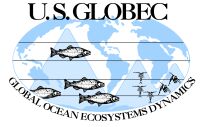August 3, 2002
Heading east towards Coos Bay11:00 a.m.: The weather
is holding and making for another excellent day aboard the Revelle.
Conditions are ideal for the Bird and Mammal Observation Team.
Co-Principle Investigators Cyndy Tynan and Dave Ainley along with
observers Tom Ryan and Chuck Alexander are set up on the deck just
below the bridge. Special windscreen panels, observation
seats, and high-powered binoculars are set up and are used by the team
during daylight hours. Sightings from yesterday (August 2)
include Sperm, Blue, Humpback, and Minke Whales as well as Dall's
Porpoises and Elephant Seals. Many whales have been
spotted this morning as well (see spout photo below). Observations
by the team will be combined with the other data collected on this
cruise.
.jpg) .jpg) .jpg)
.jpg) .jpg) .jpg)
4 p.m.: The nice weather has continued all day. The
ship is settling into a routine that will last at least for the next
few days until we reach the end of the mesoscale survey at the
California border. Several of the crew took advantage of the
nice day to get some exercise on deck.
.jpg) .jpg) .jpg) .jpg)
10:30 p.m.: Chief Scientist report for August 3:
We recently completed lines 5 and 6 of the Mesoscale survey. Winds and
seas are calm and we had a great cruise down the coast near Coos Bay.
Lots of whale sightings this morning near the middle of line 6
(43.5N).
We did a near flyby of New Horizon along line 6 at 125 10'W (1/2 hour
between occupations of that spot). There were several groups (4-12
individuals) of sea lions off the Coos Bay entrance, along with
several
salmon trollers that the Revelle wound its way through. Hmmmm... I
think
I can guess what those sea lions were after!
In the 5-m SST from SeaSoar there is cold water near the coast and a
streamer of cold water extending offshore near 44N out to at least
126W.
5-m chlorophyll was highest over the Bank, but elevated values were
also
found in that cold water feature far offshore. Lots of downward
excursions of high chl water (down to ~50m), likely associated with
the
"egg beater" motion of the meanders, filaments and eddies in this
well-developed upwelling system.
About 8pm Saturday (8/3) the ship's Knudsen echosounder failed just as
we
were about to turn offshore near 7E. We flew the SeaSoar
conservatively
based on the ADCP and HTI depth outputs. We didn't get great depth
coverage over the shelf, but better to error on the side of caution.
The
SIO computer tech and Linda Fayler swapped in the ship's ODEC
Bathy2000
12.5 kHz echosounder and had it done in about an hour and a half.
Meanwhile we did a very close and coordinated flyby of New Horizon on
the
FM line at 124 36'W. The winds were weak and seas calm, which made for
a
beautiful viewing of New Horizon at dusk.
Tomorrow morning we'll conduct a safety meeting to go over the
procedures
for deploying the CTD/rosette, the bio-optics profiling package and
the
TSRB in anticipation of switching to those activities after the first
Mesoscale survey.
---Jack Barth, Chief Scientist R/V Roger Revelle
filed 2230 PDT August 3 2002
All Video clips are created in Windows Media
Player format. The broadband version is for cable or DSL users. The
56K version is for dial-up modem internet users. Find the
Windows Media Player for other operating systems here.
Previous update August 2
Next update August 4 |


.jpg)
.jpg)
.jpg)
.jpg)
.jpg)
.jpg)
.jpg)
.jpg)
.jpg)
.jpg)


